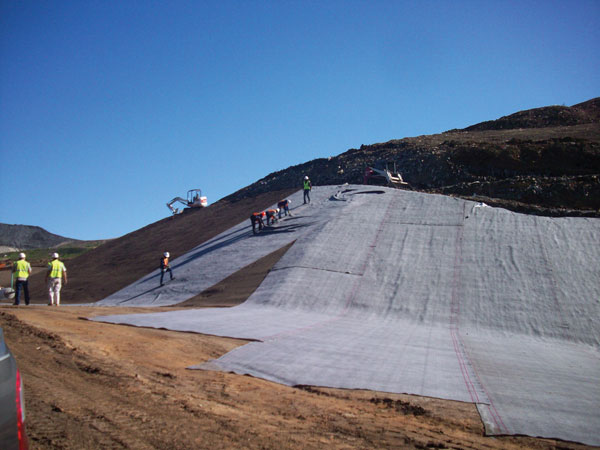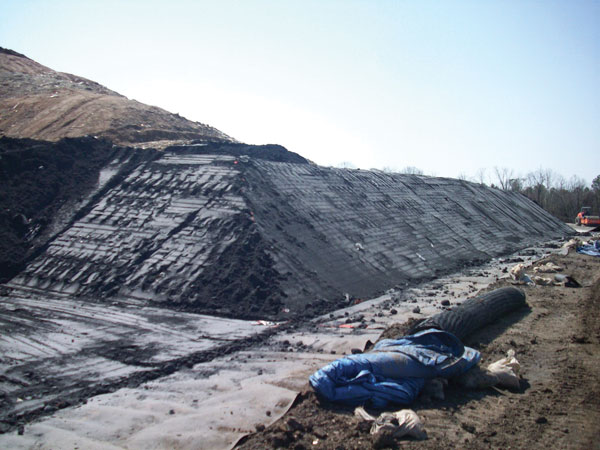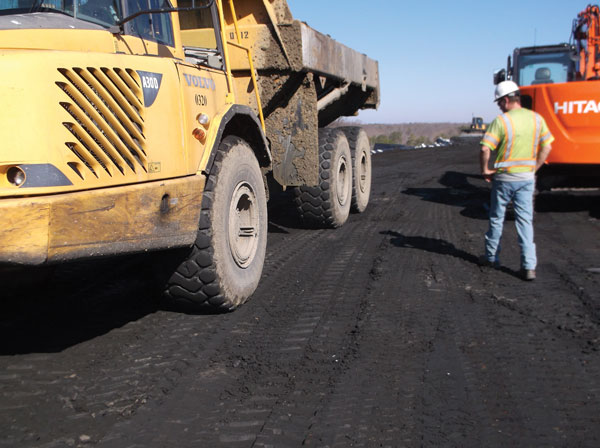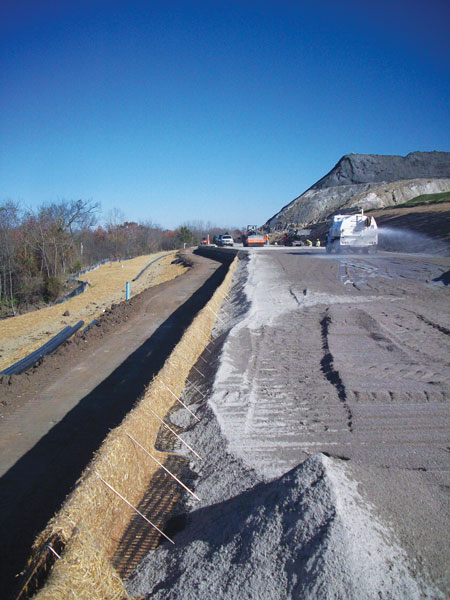The implementation of best practices in any landfill expansion solution demands a constant tether to mitigate risk in the areas of safety, environmental impact, and economics. The implementation of an eMSE berm helps obtain these goals by improving the solution.
By John P. Swenson and Jeffrey Crate, P.G.
In today’s challenging regulatory and environmental climate, expanding an existing landfill is a very daunting task. Public, private, big and small landfill owners have had traditional MSE berm strategies available to them for years, but those come with challenges, most notably stability and cost.
Encapsulated Mechanically Stabilized Earthen (eMSE) berms were developed to address those issues. They offer the same advantages as traditional MSE berms, but are safer and less expensive, making them a better option for landfill expansion applications. This article will describe eMSE berms, why some consider them superior to traditional MSE berms and give the best practices for using them, as well as traditional MSE berms, to expand landfills.

Traditional Versus eMSE Berms
Traditional MSE berms are constructed using layers of compacted fill material, called lifts, separated by geogrids, which provide reinforcement. This structure enables them to have steeper slopes than berms built without reinforcement. However, while the reinforcement is easy to design and specify, the lifts can be more challenging, particularly in specifying the characteristics of the materials to be used. A 2013 white paper1 concluded that using fill material that has low hydraulic conductivity in a berm without providing adequate drainage relief increases the buildup of pore pressure within the material, which, in turn, increases the
failure risk of the berm. A 2018 update2 to that white paper said that using material with low hydraulic conductivity as fill in berms is a growing trend, which places a growing importance on dealing with the resulting pore pressures.
In eMSE berms, the hydraulic conductivity of fill material is less relevant. That is because the berms are fully encapsulated by geomembrane liner systems that prevent excessive moisture from migrating into the fill. As a result, eMSE berms are less prone to failure from water infiltrating them and degrading their stability than traditional MSE berm systems.3

Since the encapsulation gives eMSE berms a feature that traditional MSE berms lack, by inference eMSE berms would be more expensive to build than traditional MSE berms. The opposite is true for multiple reasons. The most significant is that encapsulation allows the use of a wider range of fill materials; thus, not only can eMSE berms source fill material that is less expensive than the fill material required in traditional MSE berms, but acceptable fill materials can also include those for which disposal revenue is received, such as impacted soils, incinerator ash and coal ash.
Obviously, being paid to use fill material rather than having to purchase it reduces construction costs. It also can make larger eMSE berms more economical than smaller ones and enable landfill owner/operators to expand capacity with an eye to the long-term. Additionally, the reduced concern of construction cost means landfill owner/operators can build berms sufficient to enhance post-closure configuration/use, for instance, as public parks.

Expanding a Landfill
Regardless of the type of berm system used to expand a landfill, much of the work occurs before actual construction begins. That work involves talking to the landfill operator to formulate a concept based on its needs and wants, turning that concept into a design and negotiating a contract that both treats the landfill operator fairly and adequately compensates the company building the berm system. That compensation should cover not just construction, but also pre- and post-construction work that meets the needs of the landfill operator, the community in which the landfill is located and the regulators that oversee the landfill.
Meeting with the Landfill Operator
The first step in the process is a meeting with the landfill operator to create a concept of what it wants to build. Considerations include the landfill’s current size, the amount by which the
operator wants to expand it, whether the landfill will be receiving material, such as coal combustion residues (CCR) that can become the berm fill in a manner constituting beneficial reuse, the landfill’s location and its surrounding community’s view of it, the landfill’s proposed post-closure use, and the amount the operator has budgeted for the expansion. This provides an understanding of the landfill operator’s concerns and expectations, as well as the feedback needed to proceed to the design phase.
Collaborative Team Process
Expanding a landfill is a collaborative process that requires a team consisting of the landfill operator, the landfill’s engineer of record, engineers who are familiar with eMSE berms, a material
procurement firm and a construction firm. After the concept for the expansion has been formulated and a project team has been established, the design process begins. Here, the options become more specific and choosing one over the other more directly affects what the finished structure will look like and be able to accomplish. Tradeoffs can be involved, but if the fill for the berms can be a beneficial use material such as CCR that the landfill operator is getting paid to take, it opens a wide range of possibilities, especially concerning the berm’s size. Generally, MSE berms are built to minimize fill, to satisfy the minimum requirements of stability and regulatory approval. However, when configuring an eMSE berm using beneficial use material as fill, it makes sense to use as much of the revenue-generating material as possible, i.e., meaning that it makes sense to maximize the size of the berm to best meet the owner/operator’s objectives. Obviously, this enhances the owner/operator’s options and potentially maximizes the capacity and asset value of the facility.

Identify Concerns
There are limits on size of course. Property lines, setbacks, existing infrastructure, and existing waste management boundaries (WMB) determine the type of eMSE berm to be used, its size, and its maximum height and length. Best practices monitor the design changes and their effect on safety, airspace and cost expectations.
To make sure that landfill owners/operators’ problems are solved rather than exacerbated, all of their concerns and expectations should be identified before shovel-meets-ground and verify that the proposed solution addresses and meets them. The concerns may have to do with the landfill’s neighbors’ feelings about the expansion or the permitting process, while the expectations may be that the expansion will be constructed in a way that increases the ease of transferring the landfill to a post-closure use.
Properly Designing and Implementing
A properly designed and planned eMSE berm system can help the team achieve all of these things. By enabling the fill in the berms to be a substance that is being repurposed for a beneficial use, it can address landfill owners’/operators’ potential cost concerns and make a landfill expansion environmentally beneficial—giving regulators another reason to approve it. When a landfill’s neighbors are concerned about the fill material, their concerns can be addressed by pointing out that an eMSE berm system isolates the material, as accomplished in the landfill expansion described in the accompanying case study (see Expanding a Landfill in Virginia Case Study). Using an eMSE berm system also can minimize concerns that a landfill’s neighbors and regulators may have about a proposed expansion by enabling a vertical expansion rather than a land-consuming, neighborhood-impacting horizontal expansion.
Vertical expansions do not require an increase in footprint, thus offering more capacity using much the same infrastructure already in place; easing approvals and costing less to construct than horizontal ones. An eMSE berm system requires a managed program for procuring beneficial use material. That program needs to comply with local regulations as well as the proposed construction
phasing so that operational considerations such as stockpiling can be minimized.
Another best practice is to make sure the plan has enough flexibility so that they can be easily altered if necessary. The case study contains an example where a proposed expansion was modified to accommodate the landfill operator signing a contract to accept coal ash and wanting to use as much of it as possible as berm fill.
Mitigate Risk
In conclusion, the implementation of best practices in any landfill expansion solution demands a constant tether to mitigate risk in the areas of safety, environmental impact, and economics. The implementation of an eMSE berm helps obtain these goals by improving the solution. | WA
Expanding a Landfill in Virginia
In 2011, when Shoosmith Bros. Inc. needed to expand a municipal solid waste (MSW) landfill in Chester, VA, it reached out to EnCAP-IT and they began work on a solution package using the patented method of designing and building an encapsulated mechanically stabilized earthen (eMSE) berm, called the safeBERM® system.
After Shoosmith won a contract for the landfill to take in roughly 175,000 to 200,000 tons of fly ash a year from a local cogeneration plant, EnCAP-IT determined that the safeBERM® system’s design parameters and safeguards would enable it to use the coal combustion residuals (CCR) as repurposed material in the eMSE berm. EnCAP-IT planned to build at the landfill in a way that would comply with potential future regulations.
Shoosmith wanted to use all the fly ash obtained in the berm, so it asked EnCAP-IT to give the berm a full encapsulation design rather than the initial concept of separating and encapsulating the CCR from select soil fill using an internal “bladder”. Instead of the encapsulation designed within the berm, the full encapsulation design placed the geomembrane on the berm’s outer face. As EnCAP-IT continually evaluates and updates new and innovative configurations, they were able to accommodate Shoosmith’s request in a timely and efficient manner.
The public perception of CCR presented yet another challenge, but collectively EnCAP-IT was able to demonstrate superior environmental protection due to the effective safeBERM’ s isolation of the material.
When fully constructed, EnCAP-IT’s eMSE berm at Shoosmith’s landfill was 3,532 feet long, ranged from 52 feet to 65 feet tall, and resulted in an additional 2.6 million cubic yards of capacity. The
project used more than 800,000 cubic yards of non-capacity consuming and revenue-generating CCR.
John P. Swenson is the Founder, Inventor and Managing Partner of EnCAP-IT (Glen Allen, VA). During his 26+-year career in the waste industry—at Republic Services, Laidlaw Waste Systems, Capital Environmental Services, Casella Waste Systems, Winter Bros. Waste Systems, Enviro Solutions, and Waste Associates—he has learned all facets of nonhazardous solid waste management. Over 13 years ago, he put his broad knowledge of waste and business management to work to become a leader in responsible environmental stewardship by promoting EnCAP-IT’s patented safeBERM® innovations to help the waste, power and other industries adopt methods for more efficient, environmentally friendly, cost-effective nonhazardous waste disposal and responsible reuse. He can be reached at [email protected].
Jeffrey Crate, P.G. is President of Waste Resource Services, LLC (Blacksburg, VA), catering exclusively to the needs of the waste management industry. He has experience in more than 20 states and abroad and has more than 35 years of overall waste management experience. His work has encompassed landfill design and permitting, environmental monitoring, waste management infrastructure, and in assisting owners with planning, management and operations. He is involved with several eMSE projects partnered with EnCAP-IT using safeBERM® (eMSE berm) technology. He can be reached at [email protected].
Notes
Robert M. Koerner, George R. Koerner. “A data base, statistics and recommendations regarding 171 failed geosynthetic reinforced mechanically stabilized earth (MSE) walls.” Geosynthetic Institute. January 7, 2012
Robert M. Koerner, George R. Koerner. “An extended data base and recommendations regarding 320 failed geosynthetic reinforced mechanically stabilized earth (MSE) walls.” Geosynthetic Institute. November 2018.
Warwick, Katherine, et al. “The Benefits of an Encapsulated Mechanically Stabilized Earthen (eMSE) Berm,” Waste Advantage Magazine, September 30, 2019.
